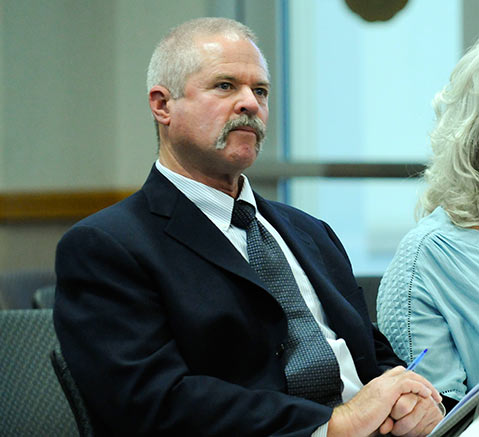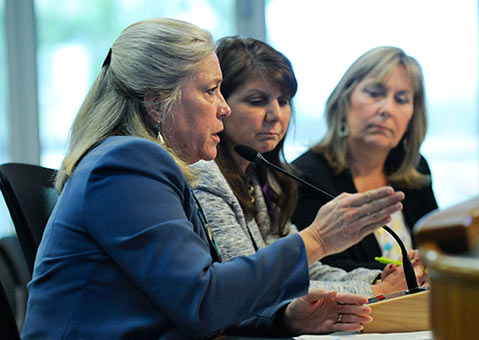Tom Franklin’s Quest
County Adopts Test Program for Mentally Ill Who Refuse Treatment

a troubled relative and others with mental illnesses who won’t accept treatment.
Tom Franklin figured he’d seen everything when he retired as fire chief in 2009 after a 32-year career with the county’s fire department. He’d witnessed flames fueled by 100-mile-an-hour winds keep pace with his truck as he floored it to safety during a 10,000-acre fire. Four people, as Franklin described it, “burned up” in that one, including an assistant fire chief and dozer operator. For 25 years, Franklin, assigned to Station 13 by San Marcos High School, saw more than his fair share of car-crash carnage on Highway 154, extricating both survivors and corpses from the wreckage.
Two weeks ago, Franklin — a civilian now — watched in horror as a close family member was arrested at the intersection of Highway 154 and Foxen Canyon Road after plowing a stolen Jeep Rubicon into an errant donkey crossing the road. As Franklin’s relative was walking up to drag the dead donkey to the side, a surprised motorist following behind swerved violently to avoid a collision and flew off the road. By the time the fire department arrived, the motorist, a 53-year old woman, was dead.
That nightmare really began in earnest six years earlier. That’s when Franklin’s relative, a promising film studies student at USC and former high school athlete, began exhibiting signs of mental illness. (Out of deference to his family’s privacy, Franklin requested that his relative’s name not be used.) Initially, Franklin didn’t believe it. But the symptoms only got worse. His relative was hearing voices and declared himself an agent of God. Franklin and his wife sought help. The relative was pushed and prodded into two stints of residential treatment. Twice he was placed in psychiatric hospitals. None of it was cheap. Insurance companies pay what they want, Franklin discovered. The family wound up burning through $300,000 in six years. Franklin’s relative would be picked up twice for trespassing, once at Hearst Castle. For one month, he lived on the streets. And he took his medications — strong anti-psychotic drugs — only when he wanted to. Mostly he didn’t think he was sick at all. And he refused treatment. That’s all too common for people, Franklin learned, who’d been diagnosed with schizoaffective disorder.
Push came to shove late this April. That’s when Franklin’s relative slammed the retired fire chief up against his kitchen stove, threatening, “I’m going to fuck you up.” What he meant by that, Franklin was told, was suicide. Somehow, Franklin managed to get off a call to 9-1-1 before his phone was snatched from his hand and broken in two.
Sheriff’s deputies showed up. They summoned mental-health workers. They, in turn, quickly concluded Franklin’s relative posed an imminent threat to himself or to others. Accordingly they had him placed on an involuntary hold at Santa Barbara County’s Psychiatric Health Facility. Three days later, Franklin said, his relative was cut loose. “He got no treatment at all,” Franklin said. The fatal Jeep-donkey incident took place just a few days later. Today, Franklin’s relative is now held in County Jail, facing charges for auto theft. The case has been transferred to a mental-health diversion court. If Franklin’s relative doesn’t take his meds, he can’t begin treatment, Franklin said. If he doesn’t get treatment, he’s going to state prison.
In the intervening six years, Franklin the firefighter became Franklin the mental-health firebrand. He joined the county’s Mental Health Commission. He became a card-carrying member of the National Alliance on Mental Illness (NAMI). He led weekly workshops for families who found themselves on the same sinking ship. And along with many other mental-health advocates, Franklin has lobbied the county supervisors to fund a small-scale pilot program known as Laura’s Law that gives judges the legal authority to “order” the most treatment-resistant mentally ill to seek and obtain outpatient psychiatric care.
Although Laura’s Law was enacted via statewide ballot initiative in 2002, funding for it didn’t become available until two years ago. For it to be effective, individual counties must opt in by a vote of their supervisors. In the past two years, Santa Barbara mental-health advocates have clamored for such a vote. Multiple times, the supervisors struggled and wrung their hands: Santa Barbara’s mental-health department, in perpetual crisis mode, was in especially serious trouble; the new department head, Alice Gleghorn, needed to focus on more immediate structural reforms before taking on the distractions of such a new and challenging initiative.

Department, discusses Laura’s Law with the Board of Supervisors on May 10th, 2016.
Tom Franklin was in the supervisors’ face on behalf of Laura’s Law at this Tuesday’s board meeting, much as he had been — in private encounters — the week before. Franklin made it clear what he did not want to hear. “I don’t want anyone to tell me how sympathetic they are,” he stated. “I don’t want sympathy. I want action.”
This Tuesday, Franklin got just that. By a 4-1 vote, the supervisors voted to spend $600,000 a year for the next three years on a pilot Laura’s Law program that would target just 10 of the county’s 142 most expensive and most stubbornly service-resistant mental-health patients. These 142 — known alternately as “frequent fliers” or “high utilizers” — make up only 4 percent of the Department of Behavioral Wellness’s mental-health caseload. But they account for 22 percent of the costs. That’s $6 million. Translated, that’s $83,000 a year per patient.
Boiled down, Laura’s Law requires Gleghorn’s teams to throw “whatever it takes” at these 10 patients, a combination of high-intensity outreach work with a sprawling menu of “wrap-around” services provided by three delivery teams. Most of these services already exist, but some do not. Some exist more in name than actual fact — like housing. If the intended recipients of all this mental-health attention still resist, Laura’s Law gives Gleghorn the authority to petition a judge to order the patient in question to accept the treatment that’s offered. Gleghorn must make nine findings before filing such a petition, chiefly that the patient has been hospitalized or incarcerated at least two times in the prior 36 months and has been clinically deemed to be “unlikely to survive safely in the community without supervision.” Any number of people have standing to petition Gleghorn’s department, including friends, relatives, and police officers, not to mention mental-health case workers.
Laura’s Law, it should be stressed, does not give the judges power to lock up any of these individuals, force them to take their medications, or place them in any restraints. Laura’s Law supporters refer to what’s known as “the Black Robe effect,” referring to the seemingly magical authority of judicial focus and attention that moves the most service resistant into therapeutic compliance. Laura’s Law does not, however, give the court authority to sentence those who refuse to cooperate to jail. For them, there is no sanction other than the renewed efforts of mental-health professionals.
Leading the charge on behalf of Laura’s Law — other than advocates with organizations such as Families ACT, NAMI, and the Santa Barbara County Mental Health Commission — was County Supervisor Doreen Farr, whose adult son’s struggles have been the subject of recent news articles. Joining her were supervisors Steve Lavagnino and Salud Carbajal. Leading the charge against were Supervisor Janet Wolf and Peter Adam, though Adam voted for the initiative — without explanation — after arguing vociferously against it.
But it fell to Alice Gleghorn, one year into her job as new director of Behavioral Wellness, to provide most of the arguments against the pilot program. While expressing sympathy for families struggling to find help for acutely mentally ill relatives, Gleghorn noted that many new programs, dollars, and resources have been marshaled into the fight against mental illness since California voters approved Laura’s Law in 2002. Millions, for example, have been raised by a special tax imposed on millionaires passed by voters in order to fund Assertive Community Treatment (ACT) teams that target the frequent fliers. Gleghorn argued that the “efficacy” of Laura’s Law was in much dispute, and she cited a handful of scholarly articles that concluded Laura’s Law has no appreciable impact on the number of mentally ill who are hospitalized, incarcerated, or homeless, when “randomized” statistical methodologies are deployed.
What does work, Gleghorn insisted, are the well-funded ACT teams reaching out to the mentally ill and providing the “whatever it takes” range of services. Santa Barbara County, she acknowledged, has been slow to achieve “whatever it takes” firepower, but is almost there. Laura’s Law, she contended, is expensive to implement, and those resources could be spent more effectively on programs like ACT. She noted that only one of the 270 clients identified by the Laura’s Law program enacted by Los Angeles County has ever been before a judge. How much impact, she wondered, could the judicial component possibly have?
Tom Franklin was not swayed. “They don’t get it,” he spat during an interview before Tuesday’s meeting. “They could put a mental-health clinic on every single corner, and my family member would not walk in the door,” he argued. “He doesn’t think he’s sick. Why would he?” If Laura’s Law is so ineffectual, Franklin and many others questioned, why have 46 states passed their own versions? Why have nine counties — including Los Angeles, San Francisco, and most recently Ventura and San Luis Obispo — embraced Laura’s Law? Why did the federal government just announce it would fund Laura’s Law–style grants to the tune of $53 million? L.A. County, by the way, reported a 78 percent drop in incarcerations and an 86 percent reduction in hospitalizations among participants of its Laura’s Law program. “You really think L.A., San Francisco, and Orange County didn’t do their due diligence?” a theatrically incredulous Franklin asked the supervisors. “Santa Barbara knows better?”
He was equally incredulous county bean counters hadn’t calculated the savings that would accrue to the Sheriff’s department, the jail, the District Attorney, and the Public Defender because of Laura’s Law. These departments, he predicted, would experience a drop in caseload because the frequent fliers — who typically rotate from jail to the streets to emergency rooms and back to Behavioral Wellness — would be reduced. Why aren’t those savings, he questioned, calibrated against the costs associated with the new program?
For Supervisor Farr, coming to the end of her two-term supervisorial career, Laura’s Law will most likely be her last hurrah. In the 12 years the supervisors have been debating the issue, she said, “The problem has still not gone away,” adding, “Twelve years is a long time to wait. The time is now. Let’s move forward.” Supervisor Janet Wolf said she was “astonished” that only one L.A. Laura’s Law client had been before a judge and expressed concern the pilot program would not be “the panacea” its supporters are hoping for and that it would imbue them with “false expectations.”
As for Tom Franklin, his family member is still in jail and still has a long road ahead of him. If Laura’s Law existed six years ago when his family member’s mental-health troubles started, Franklin suggested, maybe the outcome would have been different. “Maybe an ACT team would have shown up, and maybe a judge would have to be called in,” he said. “All I know is that every day this board puts off Laura’s Law is another day there’s going to be a case just like mine.”



